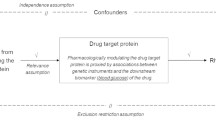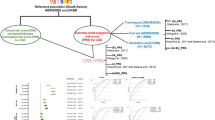Abstract
Kawasaki disease (KD) is a multi-systemic vasculitis which preferentially affects infants and children. A single nucleotide polymorphism (rs28493229) in the inositol 1,4,5-trisphosphate 3-kinase C (ITPKC) was identified to be associated with the increased risk of KD; however, in more recent studies associations have been controversial. Thus, we performed a meta-analysis, integrating case–control and transmission/disequilibrium test (TDT) studies, to investigate the relationship between this polymorphism and risk of KD. A total of ten case–control and two TDT studies, comprising 3,821 cases, 12,802 controls and 949 families, were included in this meta-analysis. There was a significant association between the C allele of rs28493229 and the increased risk of KD (OR = 1.53, 95 % CI = 1.34−1.74, P < 0.001), by the random-effects model because of heterogeneity (Q = 27.67, P heterogeneity = 0.004). Nevertheless, it was screened out by meta-regression analysis that the coronary artery lesions (CALs) status of KD could partly explain the heterogeneity, with consistently significant associations in both subgroups after stratification by CALs status. Moreover, estimates before and after the deletion of each study were similar in sensitivity analysis, indicating robust stability of the meta-analysis. This meta-analysis reveals that the functional polymorphism rs28493229 in ITPKC significantly contributes to the risk of KD.


Similar content being viewed by others
References
Rowley AH (2011) Kawasaki disease: novel insights into etiology and genetic susceptibility. Annu Rev Med 62:69–77
Huang WC, Huang LM, Chang IS, Chang LY, Chiang BL et al (2009) Epidemiologic features of Kawasaki disease in Taiwan, 2003–2006. Pediatrics 123:e401–e405
Yanagawa H, Nakamura Y, Yashiro M, Uehara R, Oki I et al (2006) Incidence of Kawasaki disease in Japan: the nationwide surveys of 1999–2002. Pediatr Int 48:356–361
Burns JC, Glode MP (2004) Kawasaki syndrome. Lancet 364:533–544
Dajani AS, Taubert KA, Gerber MA, Shulman ST, Ferrieri P et al (1993) Diagnosis and therapy of Kawasaki disease in children. Circulation 87:1776–1780
Newburger JW, Takahashi M, Gerber MA, Gewitz MH, Tani LY et al (2004) Diagnosis, treatment, and long-term management of Kawasaki disease: a statement for health professionals from the Committee on Rheumatic Fever, Endocarditis, and Kawasaki Disease, Council on Cardiovascular Disease in the Young, American Heart Association. Pediatrics 114:1708–1733
Taubert KA, Rowley AH, Shulman ST (1994) Seven-year national survey of Kawasaki disease and acute rheumatic fever. Pediatr Infect Dis J 13:704–708
Rowley AH, Shulman ST (1999) Kawasaki syndrome. Pediatr Clin North Am 46:313–329
Nakamura Y, Yashiro M, Uehara R, Oki I, Kayaba K et al (2008) Increasing incidence of Kawasaki disease in Japan: nationwide survey. Pediatr Int 50:287–290
Rauch AM, Kaplan SL, Nihill MR, Pappas PG, Hurwitz ES et al (1988) Kawasaki syndrome clusters in Harris County, Texas, and eastern North Carolina. A high endemic rate and a new environmental risk factor. Am J Dis Child 142:441–444
Davis RL, Waller PL, Mueller BA, Dykewicz CA, Schonberger LB (1995) Kawasaki syndrome in Washington State. Race-specific incidence rates and residential proximity to water. Arch Pediatr Adolesc Med 149:66–69
Park YW, Han JW, Park IS, Kim CH, Cha SH et al (2007) Kawasaki disease in Korea, 2003–2005. Pediatr Infect Dis J 26:821–823
Holman RC, Curns AT, Belay ED, Steiner CA, Schonberger LB (2003) Kawasaki syndrome hospitalizations in the United States, 1997 and 2000. Pediatrics 112:495–501
Holman RC, Curns AT, Belay ED, Steiner CA, Effler PV et al (2005) Kawasaki syndrome in Hawaii. Pediatr Infect Dis J 24:429–433
Fujita Y, Nakamura Y, Sakata K, Hara N, Kobayashi M et al (1989) Kawasaki disease in families. Pediatrics 84:666–669
Harada F, Sada M, Kamiya T, Yanase Y, Kawasaki T et al (1986) Genetic analysis of Kawasaki syndrome. Am J Hum Genet 39:537–539
Uehara R, Yashiro M, Nakamura Y, Yanagawa H (2003) Kawasaki disease in parents and children. Acta Paediatr 92:694–697
Tsai FJ, Lee YC, Chang JS, Huang LM, Huang FY et al (2011) Identification of novel susceptibility loci for Kawasaki disease in a Han Chinese population by a genome-wide association study. PLoS One 6:e16853
Lee KY, Han JW, Lee JS (2007) Kawasaki disease may be a hyperimmune reaction of genetically susceptible children to variants of normal environmental flora. Med Hypotheses 69:642–651
Onouchi Y (2009) Molecular genetics of Kawasaki disease. Pediatr Res 65:46R–54R
Cheung YF, Huang GY, Chen SB, Liu XQ, Xi L et al (2008) Inflammatory gene polymorphisms and susceptibility to Kawasaki disease and its arterial sequelae. Pediatrics 122:e608–e614
Onouchi Y, Ozaki K, Buns JC, Shimizu C, Hamada H et al (2010) Common variants in CASP3 confer susceptibility to Kawasaki disease. Hum Mol Genet 19:2898–2906
Ikeda K, Ihara K, Yamaguchi K, Muneuchi J, Ohno T et al (2008) Genetic analysis of MMP gene polymorphisms in patients with Kawasaki disease. Pediatr Res 63:182–185
Khor CC, Davila S, Shimizu C, Sheng S, Matsubara T et al (2011) Genome-wide linkage and association mapping identify susceptibility alleles in ABCC4 for Kawasaki disease. J Med Genet 48:467–472
Onouchi Y, Tamari M, Takahashi A, Tsunoda T, Yashiro M et al (2007) A genomewide linkage analysis of Kawasaki disease: evidence for linkage to chromosome 12. J Hum Genet 52:179–190
Onouchi Y, Gunji T, Burns JC, Shimizu C, Newburger JW et al (2008) ITPKC functional polymorphism associated with Kawasaki disease susceptibility and formation of coronary artery aneurysms. Nat Genet 40:35–42
Imboden JB, Pattison G (1987) Regulation of inositol 1,4,5-trisphosphate kinase activity after stimulation of human T cell antigen receptor. J Clin Invest 79:1538–1541
Macian F (2005) NFAT proteins: key regulators of T-cell development and function. Nat Rev Immunol 5:472–484
Chi H, Huang FY, Chen MR, Chiu NC, Lee HC et al (2010) ITPKC gene SNP rs28493229 and Kawasaki disease in Taiwanese children. Hum Mol Genet 19:1147–1151
Kuo HC, Yang KD, Juo SH, Liang CD, Chen WC et al (2011) ITPKC single nucleotide polymorphism associated with the Kawasaki disease in a Taiwanese population. PLoS One 6:e17370
Lin MT, Wang JK, Yeh JI, Sun LC, Chen PL et al (2011) Clinical implication of the C Allele of the ITPKC Gene SNP rs28493229 in Kawasaki disease: Association with disease susceptibility and BCG Scar reactivation. Pediatr Infect Dis J 30:148–152
Onouchi Y, Suzuki Y, Suzuki H, Terai M, Yasukawa K et al (2011) ITPKC and CASP3 polymorphisms and risks for IVIG unresponsiveness and coronary artery lesion formation in Kawasaki disease. Pharmacogenomics J. doi:10.1038/tpj.2011.45
Khor CC, Davila S, Breunis WB, Lee Y-C, Shimizu C et al (2011) Genome-wide association study identifies FCGR2A as a susceptibility locus for Kawasaki disease. Nat Genet 43:1241–1246
Peng Q, Chen CH, Wu Q, Li B, Liao J et al (2011) Association study of a functional SNP rs28493229 of ITPKC gene and Kawasaki disease in a Chinese population. Zhonghua Yi Xue Yi Chuan Xue Za Zhi 28:644–648
Lander ES, Schork NJ (1994) Genetic dissection of complex traits. Science 265:2037–2048
Kazeem GR, Farrall M (2005) Integrating case–control and TDT studies. Ann Hum Genet 69:329–335
Hedges LV, Olkin I (1985) Statistical methods for meta-analysis. Academic Press, Boston
Nicodemus KK (2008) Catmap: case-control and TDT meta-analysis package. BMC Bioinformatics 9:130
Thompson SG, Higgins JP (2002) How should meta-regression analyses be undertaken and interpreted? Stat Med 21:1559–1573
Brown TJ, Crawford SE, Cornwall ML, Garcia F, Shulman ST et al (2001) CD8 T lymphocytes and macrophages infiltrate coronary artery aneurysms in acute Kawasaki disease. J Infect Dis 184:940–943
Terai M, Kohno Y, Niwa K, Toba T, Sakurai N et al (1987) Imbalance among T-cell subsets in patients with coronary arterial aneurysms in Kawasaki disease. Am J Cardiol 60:555–559
Maury CP, Salo E, Pelkonen P (1989) Elevated circulating tumor necrosis factor-alpha in patients with Kawasaki disease. J Lab Clin Med 113:651–654
Lin CY, Lin CC, Hwang B, Chiang BN (1991) The changes of interleukin-2, tumour necrotic factor and gamma-interferon production among patients with Kawasaki disease. Eur J Pediatr 150:179–182
Berridge MJ (1993) Inositol trisphosphate and calcium signalling. Nature 361:315–325
Acknowledgments
This work was supported by the Fundamental Research Funds for the Central Universities (HUST: Nos. 2011TS019 and 2010QN005) and Science Technology Department of Zhejiang Province (2011C23085).
Conflict of interest
The authors have declared no conflict of interest.
Author information
Authors and Affiliations
Corresponding author
Electronic supplementary material
Below is the link to the electronic supplementary material.
Rights and permissions
About this article
Cite this article
Lou, J., Xu, S., Zou, L. et al. A functional polymorphism, rs28493229, in ITPKC and risk of Kawasaki disease: an integrated meta-analysis. Mol Biol Rep 39, 11137–11144 (2012). https://doi.org/10.1007/s11033-012-2022-0
Received:
Accepted:
Published:
Issue Date:
DOI: https://doi.org/10.1007/s11033-012-2022-0




